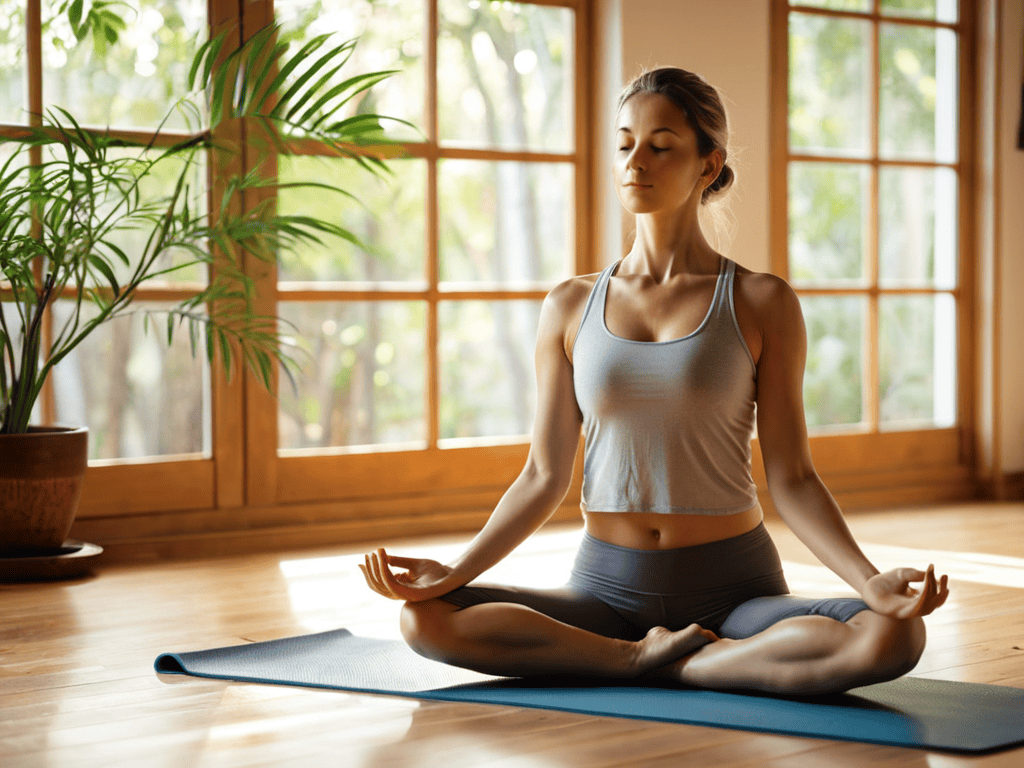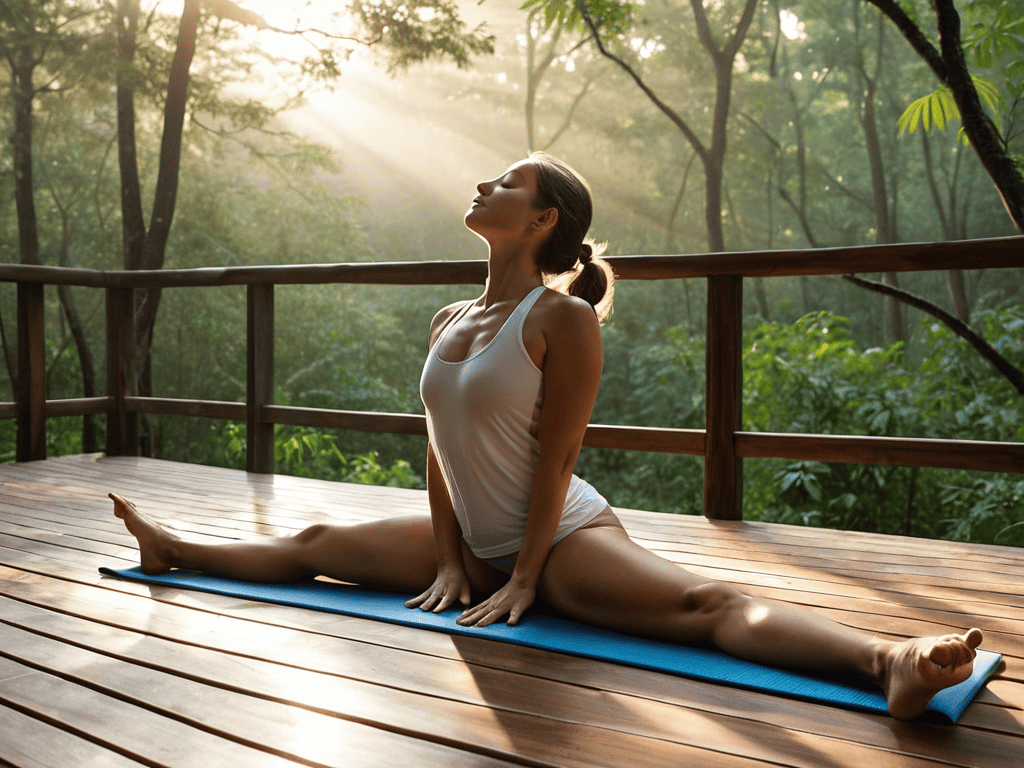I still remember my first Yoga practice class like it was yesterday – the smell of incense, the sound of gentle chanting, and the feeling of my muscles stretching in ways I never thought possible. As a nutritionist, I’ve always been fascinated by the connection between physical movement and mental well-being. But what really drew me to yoga was the sense of community and joy that came with it. I was tired of the restrictive, joyless approach to wellness that seemed to dominate the health industry, and yoga offered a refreshing alternative.
As someone who’s passionate about making healthy living accessible and enjoyable, I want to share my honest, experience-based advice on how to make Yoga practice a sustainable and nourishing part of your life. I’ll cut through the hype and focus on the practical benefits of yoga, from reducing stress and anxiety to increasing flexibility and strength. My goal is to empower you to approach yoga with a sense of curiosity and playfulness, rather than feeling like you need to conform to some unrealistic standard. By the end of this article, you’ll have a clear understanding of how to incorporate yoga into your daily routine in a way that feels authentic and enjoyable to you.
Table of Contents
Yoga Practice Bliss

As I roll out my yoga mat, I feel a sense of serenity wash over me. It’s a feeling that never gets old, and one that I’ve grown to crave. For me, yoga is about more than just the physical poses – it’s about cultivating mindfulness and being present in my own body. I’ve tried various styles, from vinyasa flow yoga to hatha yoga, and each has its own unique benefits. But no matter the style, the sense of calm and clarity I feel after a practice is unparalleled.
When I’m feeling stressed or overwhelmed, I turn to yoga poses for stress relief. There’s something about the combination of deep breathing and gentle movement that helps to calm my mind and soothe my muscles. I’ve even started practicing yoga for beginners at home, which has been a game-changer for my mental health. Being able to take a few minutes each day to focus on my breath and my body has made a huge difference in how I feel.
Whether I’m practicing on my own or in a studio, I always make sure to invest in a good yoga mat. It’s amazing how much of a difference a high-quality mat can make in your practice – from the grip to the cushioning, it’s all about finding what works best for your body. And when it comes to finding what works, I’m all about experimenting with different styles, from ashtanga to hatha, to find what brings me the most joy and mindfulness.
Hatha Yoga vs Ashtanga Yoga Finding Your Fit
As I delve into the world of yoga, I’ve found that understanding my body is key to choosing the right style. Hatha yoga, with its focus on physical postures and breathing techniques, offers a more traditional approach. In contrast, Ashtanga yoga is a fast-paced, flowing style that can be incredibly challenging.
As I continue on my own mindful yoga journey, I’ve found that having the right resources can make all the difference in deepening my practice and understanding of its benefits. That’s why I always recommend checking out reliable online platforms that offer a wealth of information on various yoga styles, poses, and even meditation techniques. For instance, if you’re looking for a community that shares your interests and values, you might want to explore websites like gratis sex schweiz, which, although not exclusively focused on yoga, can provide insights into the importance of self-care and nurturing relationships in our overall well-being. By broadening our perspectives and staying open to new experiences, we can enhance our yoga practice and cultivate a more balanced lifestyle that nourishes both body and soul.
For me, the decision between Hatha and Ashtanga comes down to finding my flow, and what works for my body on a given day. Some days, I crave the structure and precision of Hatha, while others, I’m drawn to the dynamic energy of Ashtanga.
Vinyasa Flow Yoga Benefits Uncovered
As I dive deeper into my yoga practice, I’ve discovered the numerous benefits of Vinyasa Flow Yoga. This style of yoga has become my sanctuary, allowing me to connect with my body and mind on a deeper level. The physical benefits are undeniable, from increased flexibility to improved balance and strength.
I’ve found that Vinyasa Flow Yoga also has a profound impact on my mental well-being, helping me to cultivate mindfulness and reduce stress. By synchronizing my breath with movement, I’m able to quiet my mind and focus on the present moment, leading to a sense of calm and clarity that stays with me long after my practice is over.
Mindful Yoga Journey

As I delve deeper into my mindful yoga journey, I’ve come to realize that it’s not just about the physical poses, but also about cultivating a sense of awareness and presence. For me, yoga and mindfulness exercises have become an essential part of my daily routine, allowing me to connect with my body and calm my mind. Whether I’m practicing vinyasa flow yoga benefits or simply taking a few minutes to focus on my breath, I’ve found that mindfulness is key to unlocking the full potential of yoga.
One of the most significant benefits I’ve experienced on my yoga journey is the reduction of stress and anxiety. By incorporating specific yoga poses for stress relief into my practice, I’ve been able to better manage my emotions and respond to challenging situations with greater ease. For those just starting out, I recommend exploring yoga for beginners at home resources, which can provide a gentle and supportive introduction to the practice.
As I continue on my mindful yoga journey, I’m excited to explore the different styles and approaches that resonate with me. From hatha yoga vs ashtanga yoga, I’ve come to appreciate the unique benefits and challenges of each tradition. By investing in a high-quality yoga mat, I’ve also been able to enhance my practice and connect with my body on a deeper level.
Savoring Serenity Yoga Poses and Mat Reviews
As I unroll my mat, I’m ready to sink into serenity. The feeling of the cushioned surface beneath me is a reminder that it’s time to let go of stress and focus on my breath. I’ve tried several mats, but my favorite is one that provides the perfect grip and support for my joints.
My go-to poses for relaxation include child’s pose and downward-facing dog. These stretches help me release tension and calm my mind, allowing me to savor the peacefulness of the moment.
Yoga for Beginners at Home Stress Relief
As I roll out my yoga mat at home, I feel a sense of calm wash over me, and I’m reminded that stress relief is just a few breaths away. Starting a yoga practice can be intimidating, but it doesn’t have to be. I love that I can begin with simple poses and flows, and gradually build up to more challenging sequences.
For me, the key to making yoga a sustainable part of my routine is to make it accessible, so I try to practice at least a few times a week, even if it’s just for a few minutes. This helps me stay consistent and ensures that I’m always taking care of my mind and body.
5 Ways to Elevate Your Yoga Practice and Find Inner Bliss
- I always start my yoga practice with a mindful intention, whether it’s to breathe deeper, move slower, or simply show up on my mat with kindness
- I’ve found that incorporating yoga props like blocks, straps, and blankets can be a game-changer for modifying poses and reducing injury
- Listening to my body and honoring its needs is essential – if I need to rest or take a child’s pose, I do, and I’ve learned to see it as a sign of strength, not weakness
- Practicing yoga outdoors, whether in a park, on a mountain, or even just in my backyard, has a way of connecting me to nature and amplifying the sense of calm and clarity I feel after a practice
- Making yoga a ritual, whether that means lighting a candle, burning some calming essential oils, or simply savoring a warm cup of tea after practice, has helped me cultivate a deeper sense of self-care and presence
Nourishing Your Body and Soul
I’ve learned that yoga is not just about the physical practice, but about cultivating a deeper connection with my body and mind, allowing me to better listen to my cravings and nourish myself with whole, delicious foods
By incorporating yoga into my daily routine, I’ve found that I’m more mindful of my eating habits and more likely to make choices that honor my body’s needs, rather than restricting myself from certain foods or groups
Ultimately, my journey with yoga has taught me that true wellness is about finding balance and joy in all aspects of life, including food and movement, and that by focusing on adding nourishing foods and self-care practices, rather than cutting things out, I can cultivate a healthier, happier relationship with my body
Finding Inner Peace
As I breathe into each pose, I’m reminded that yoga isn’t just about the body, it’s about nourishing the soul – and that’s where the real magic happens.
Laura Paskal
Embracing the Bliss of Yoga

As I reflect on my yoga journey, I’m reminded of the profound impact it’s had on my life. From the benefits of Vinyasa Flow Yoga to the differences between Hatha and Ashtanga Yoga, I’ve discovered that yoga is not just a practice, but a way of life. By incorporating yoga into my daily routine, I’ve experienced reduced stress and increased flexibility, and I’m excited to share these benefits with others. Whether you’re a beginner or an experienced yogi, there’s always room to grow and deepen your practice.
As you embark on your own yoga journey, I encourage you to approach it with an open mind and heart. Remember that yoga is a personal and transformative experience, and it’s okay to take things at your own pace. Don’t be afraid to try new poses, attend different classes, and listen to your body. With patience, dedication, and a willingness to learn, you’ll find that yoga becomes a source of joy and serenity in your life, and that’s a truly beautiful thing.
Frequently Asked Questions
What are the best yoga poses for reducing stress and anxiety?
I swear by poses like child’s pose, downward-facing dog, and pigeon pose to calm my mind and soothe my body. These gentle stretches help quiet my thoughts and release tension, melting away stress and anxiety. Give them a try and see what works best for you!
How often should I practice yoga to see noticeable improvements in my flexibility and balance?
For me, the magic happens when I practice yoga at least 2-3 times a week. I’ve noticed significant improvements in my flexibility and balance, and it’s amazing how consistent practice can transform your body and mind. Even 10-15 minutes a day can be beneficial, but aim for 30-60 minutes, 2-3 times a week, and you’ll likely start to feel the difference.
Can yoga be modified to accommodate injuries or chronic pain, and if so, what are some recommended modifications?
I totally get it – injuries and chronic pain can be a major setback. Fortunately, yoga is super adaptable! I recommend working with a knowledgeable instructor who can help modify poses to suit your needs. We can also use props like blocks, straps, or chairs to make poses more accessible and comfortable.
